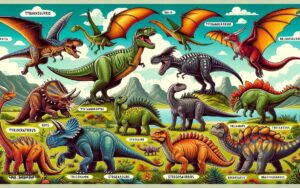Are Dinosaurs Accurate
It's a curious coincidence that the creatures who roamed the Earth millions of years ago still captivate our imagination today. Yet, as professionals in paleontology push the boundaries of technology and sift through the earth's layers, they often find that our popular representations of dinosaurs may not be as accurate as once thought.
From the texture of their skin to the color of their feathers, new discoveries continually challenge our preconceptions. This opens up a fascinating discussion: how much of what we think we know about these ancient beings is influenced by modern interpretations, and what revelations lie just beneath the surface, waiting to redefine our understanding of prehistoric life?
Key Takeaways
- Traditional portrayals of dinosaurs often lack accuracy due to new feathered dinosaur findings.
- Technological advances like CT scans and laser-stimulated fluorescence significantly improve our understanding of dinosaur appearances.
- Misconceptions about dinosaur postures and gait are being corrected with recent research.
- Interdisciplinary studies and case examples like Velociraptor and T. rex challenge and refine our visualizations of dinosaurs.
Fossil Interpretation Challenges
One of the primary challenges in accurately interpreting dinosaur fossils stems from the incomplete nature of the fossil record, which often leaves paleontologists piecing together fragmented evidence to reconstruct these ancient creatures.
This scarcity of complete specimens forces researchers to rely heavily on comparative anatomy, inferring the appearance and behavior of dinosaurs based on their closest living relatives, such as birds and reptiles. Yet, this method isn't foolproof, as evolutionary paths can diverge significantly, leading to potential inaccuracies in our reconstructions.
Moreover, the process of fossilization itself can distort or obliterate key features. Consequently, despite rigorous scientific methods, there remains a degree of uncertainty in our interpretations, highlighting the complexity of piecing together life from millions of years ago.
Technological Advances in Paleontology
Recent technological advancements have significantly enhanced our ability to analyze and interpret dinosaur fossils, offering new insights into their ancient world. High-resolution imaging techniques, such as computed tomography (CT) scans, allow scientists to peer inside fossils without damaging them, revealing intricate details about dinosaurs' anatomical structures. This has led to a deeper understanding of their physiology and behavior.
Additionally, laser-stimulated fluorescence (LSF) is providing clues about soft tissues and skin patterns that were previously impossible to detect. Moreover, digital modeling and 3D printing have revolutionized the reconstruction of dinosaur skeletons, enabling more accurate representations of their posture and gait. These tools have collectively pushed the boundaries of paleontological research, transforming our comprehension of these prehistoric creatures and their ecosystems, ensuring that our reconstructions and hypotheses are increasingly grounded in empirical evidence.
Misconceptions About Dinosaur Appearances
Despite these technological advances in paleontology, numerous misconceptions about dinosaur appearances persist, shaping our understanding less accurately than current evidence suggests.
One prevailing myth is that all dinosaurs had scaly skin, akin to modern reptiles. Recent findings, however, reveal that many species sported feathers or feather-like structures, challenging the traditional, scale-centric imagery.
Another common error involves the posture and gait of these ancient creatures. Long-depicted with dragging tails and upright limbs, research now indicates a more dynamic stance with horizontal tails and limbs under the body, similar to modern birds.
These inaccuracies stem from early interpretations and limited fossil records, but as new evidence emerges, it's crucial to adjust our perceptions to align with scientific discoveries, enhancing both accuracy and appreciation of these ancient beings.
Evolution of Dinosaur Science
Over the years, our understanding of dinosaurs has dramatically transformed, thanks to groundbreaking research and innovative technological applications in paleontology. Early studies relied heavily on fossilized bones, leading to significant gaps in knowledge about dinosaur skin, coloration, and behavior.
However, recent advancements in imaging techniques and molecular biology have revolutionized our approach. Techniques like CT scanning allow scientists to examine fossils in unprecedented detail, revealing internal structures without damaging specimens. Furthermore, the discovery of preserved soft tissues and biomolecules has provided new insights into dinosaur physiology and evolution.
These technological breakthroughs, combined with a more sophisticated understanding of evolutionary biology, have enabled paleontologists to construct a more accurate and dynamic picture of dinosaur life, challenging long-standing assumptions and continuously reshaping our interpretations of these ancient creatures.
Case Studies: Reimagining Dinosaurs
Several case studies have dramatically reshaped our understanding of dinosaurs, highlighting the significant impact of technological advancements and interdisciplinary research in paleontology. These investigations reveal:
- Velociraptor Feather Evolution: Advanced microscopy and fossil analysis have provided evidence that Velociraptors likely had feathers, challenging previous depictions of these creatures as solely reptilian.
- Tyrannosaurus Rex Posture: Biomechanical modeling suggests the T. rex stood with its body more horizontally and tail off the ground, a stark contrast to the upright posture once thought to be accurate.
- Dinosaur Vocalization: Research into the structure of dinosaur skulls and comparison with modern descendants indicates some dinosaurs may have produced sounds more similar to birds than reptiles, offering insights into their behavior and social interactions.
These case studies not only refine our visualizations but deepen our comprehension of dinosaur biology and ecology.
Conclusion
In conclusion, while technological strides in paleontology have dramatically refined our understanding of dinosaurs, the journey from fossil to fully realized creature remains fraught with challenges. Misconceptions persist, shadowed by ever-evolving scientific insights.
Yet, through reimagining dinosaurs in light of new discoveries, we witness a dynamic narrative unfold—a juxtaposition of past misconceptions against a backdrop of sharpened accuracy. This evolutionary tale of dinosaur science, rich in detail and analysis, underscores the complex interplay between established beliefs and groundbreaking revelations.




